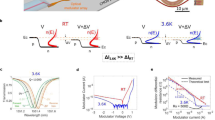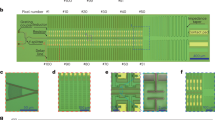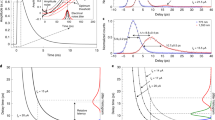Abstract
Optical-to-electrical conversion, which is the basis of the operation of optical detectors, can be linear or nonlinear. When high sensitivities are needed, single-photon detectors are used, which operate in a strongly nonlinear mode, their response being independent of the number of detected photons. However, photon-number-resolving detectors are needed, particularly in quantum optics, where n-photon states are routinely produced. In quantum communication and quantum information processing, the photon-number-resolving functionality is key to many protocols, such as the implementation of quantum repeaters1 and linear-optics quantum computing2. A linear detector with single-photon sensitivity can also be used for measuring a temporal waveform at extremely low light levels, such as in long-distance optical communications, fluorescence spectroscopy and optical time-domain reflectometry. We demonstrate here a photon-number-resolving detector based on parallel superconducting nanowires and capable of counting up to four photons at telecommunication wavelengths, with an ultralow dark count rate and high counting frequency.
This is a preview of subscription content, access via your institution
Access options
Subscribe to this journal
Receive 12 print issues and online access
$209.00 per year
only $17.42 per issue
Buy this article
- Purchase on Springer Link
- Instant access to full article PDF
Prices may be subject to local taxes which are calculated during checkout





Similar content being viewed by others
References
Simon, C. et al. Quantum repeaters with photon pair sources and multimode memories. Phys. Rev. Lett. 98, 190503 (2007).
Knill, E., Laflamme, R. & Milburn, G. J. A scheme for efficient quantum computation with linear optics. Nature 409, 46–52 (2001).
Fujiwara, M. & Sasaki, M. Direct measurement of photon number statistics at telecom wavelengths using a charge integration photon detector. Appl. Opt. 46, 3069–3074 (2007).
Gansen, E. J. et al. Photon-number-discriminating detection using a quantum-dot, optically gated, field-effect transistor. Nature Photon. 1, 585–588 (2007).
Kardynal, B. E. et al. Photon number resolving detector based on a quantum dot field effect transistor. Appl. Phys. Lett. 90, 181114 (2007).
Rosenberg, D., Lita, A. E., Miller, A. J. & Nam, S. W. Noise-free high-efficiency photon-number-resolving detectors. Phys. Rev. A 71, 1–4 (2005).
Zambra, G. et al. Counting photoelectrons in the response of a photomultiplier tube to single picosecond light pulses. Rev. Sci. Instrum. 75, 2762–2765 (2004).
Waks, E. et al. High-efficiency photon-number detection for quantum information processing. IEEE J. Sel. Top. Quant. 9, 1502–1511 (2003).
Waks, E. et al. Direct observation of nonclassical photon statistics in parametric down-conversion. Phys. Rev. Lett. 92, 113602 (2004).
Yamamoto, K. et al. Development of multi-pixel photon counter (MPPC). IEEE Nucl. Sci. Symp. Conf. Record 2006 2, 1094–1097 (2006).
Jiang, L. A., Dauler, E. A. & Chang, J. T. Photon-number-resolving detector with 10 bits of resolution. Phys. Rev. A 75, 62325 (2007).
Achilles, D. et al. Fiber-assisted detection with photon number resolution. Opt. Lett. 28, 2387–2389 (2003).
Fitch, M. J., Jacobs, B. C., Pittman, T. B. & Franson, J. D. Photon-number resolution using time-multiplexed single-photon detectors. Phys. Rev. A 68, 043814 (2003).
Dauler, E. A. et al. Multi-element superconducting nanowire single-photon detector. IEEE Trans. Appl. Superconductivity 17, 279–284 (2007).
Gol'tsman, G. N. et al. Picosecond superconducting single-photon optical detector. Appl. Phys. Lett. 79, 705–707 (2001).
Kerman, A. J. et al. Kinetic-inductance-limited reset time of superconducting nanowire photon counters. Appl. Phys. Lett. 88, 111116 (2006).
Mattioli, F. et al. Electrical characterization of superconducting single-photon detectors. J. Appl. Phys. 101, 054302 (2007).
Gol'tsman, G. N. et al. Fabrication of nanostructured superconducting single-photon detectors. IEEE Trans. Appl. Superconductivity 13, 192–195 (2003).
Gol'tsman, G. et al. Middle-infrared to visible-light ultrafast superconducting single-photon detectors. IEEE Trans. Appl. Superconductivity 17, 246–251 (2007).
Korneev, A. et al. Sensitivity and gigahertz counting performance of NbN superconducting single-photon detectors. Appl. Phys. Lett. 84, 5338–5340 (2004).
Lee, H. et al. Towards photostatistics from photon-number discriminating detectors. J. Modern Opt. 51, 1517–1528 (2004).
Rosfjord, K. M. et al. Nanowire single-photon detector with an integrated optical cavity and anti-reflection coating. Opt. Express 14, 527–534 (2006).
McIntyre, R. J. Multiplication noise in uniform avalanche diodes. IEEE Trans Electron. Dev. 13, 164–168 (1966).
Semenov, A. D., Gol'tsman, G. N. & Korneev, A. A. Quantum detection by current carrying superconducting film. Physica C 351, 349–356 (2001).
Miller, A. J., Nam, S. W., Martinis, J. M. & Sergienko, A. V. Demonstration of a low-noise near-infrared photon counter with multiphoton discrimination. Appl. Phys. Lett. 83, 791–793 (2003).
Acknowledgements
This work was supported by the Swiss National Foundation through the ‘‘Professeur boursier’ and NCCR Quantum Photonics programs, EU FP6 STREP ‘SINPHONIA’ (contract no. NMP4-CT-2005-16433), EU FP6 IP ‘QAP’ (contract no. 15848), the grant ‘Non-equilibrium processes after IR photon absorption in thin-film superconducting nanostructures’ from the Russian Agency on Education and grant no. 02.445.11.7434 from the Russian Ministry of Education and Science for support of leading scientific schools. The authors thank B. Deveaud-Plédran, B. Dwir and H. Jotterand for useful discussion and technical support and the Interdisciplinary Centre for Electron Microscopy (CIME) for supplying TEM and SEM facilities. A.G. gratefully acknowledges a PhD fellowship at University of Roma TRE.
Author information
Authors and Affiliations
Corresponding author
Rights and permissions
About this article
Cite this article
Divochiy, A., Marsili, F., Bitauld, D. et al. Superconducting nanowire photon-number-resolving detector at telecommunication wavelengths. Nature Photon 2, 302–306 (2008). https://doi.org/10.1038/nphoton.2008.51
Received:
Accepted:
Published:
Issue Date:
DOI: https://doi.org/10.1038/nphoton.2008.51
This article is cited by
-
Photon Number Resolution with an Iridium Optical Transition Edge Sensor at a Telecommunication Wavelength
Journal of Low Temperature Physics (2023)
-
Integrated photonic platforms for quantum technology: a review
ISSS Journal of Micro and Smart Systems (2023)
-
Even- and odd-orthogonality properties of the Wigner D-matrix and their metrological applications
Quantum Information Processing (2023)
-
Monostable stochastic resonance activation unit-based physical reservoir computing
Journal of the Korean Physical Society (2023)
-
Theoretical studies on quantum imaging with time-integrated single-photon detection under realistic experimental conditions
Scientific Reports (2022)



